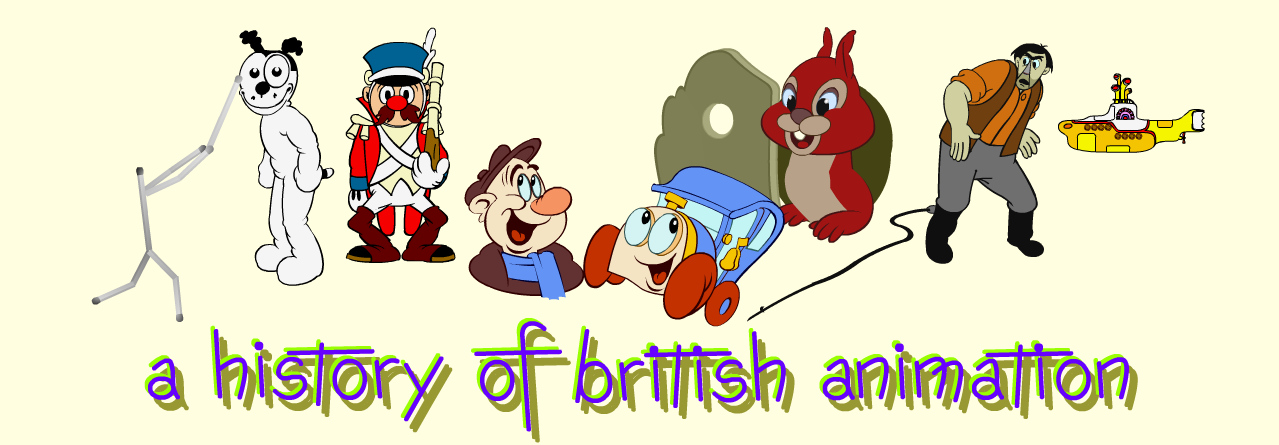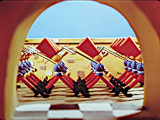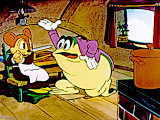

|
 | George Pal(1908-1980) |  |
||
|
George Pal was a Hungarian American who worked in German, France and the Netherlands, before emigrating to the USA, but never in Britain. This, strictly speaking, puts him outside the parameters of this website. However, his studio at Eindhoven produced two series of animated advertising films for the J W Thompson advertising agency in London – at least five model-animation films for Horlicks and three cel-animated ones for Rinso – as well as a couple of Bush Radio commercials, so I'm including him here. György Pál Marczincsak was born in Cegléd, Hungary, on 1 February 1908. His parents were travelling performers and he was raised by his grandparents, who had been members of the National Theatre in Budapest. He trained as an architect and as part of his course worked as a carpenter, which he enjoyed so much he continued for a second year. Unable to find employment as an architect György started work at Hunnia Films in Budapest, designing title cards and lobby posters for their silent films. He started to make animated cartoons, and in 1930 he married Elisabeth Josepha "Zsoka" Grandjean, with whom he later had two sons. Finding animation wasn't paying the bills the couple moved to Berlin, where in 1931 he joined the UFA studio, quickly becoming head of their animation department. After a couple of years he set up his own company, Trickfilmstudio GmbH, with businessman Paul Wittke Jr, bringing with him a trainee animator from UFA named Peter Sachs. Tiring of drawn animation, Pal started experimenting with animating three-dimensional objects, starting with dancing cigarettes. His love of woodworking led him to make a series of wooden figures representing the various positions of a drawn animated character, which could be shot on a model set frame by frame. This allowed his models the illusion of stretch and squash, so important in two-dimensional cartoon animation. He patented his system as the “Pal-Doll” technique. Initially he made a complete figure for each position. This was not quite as laborious as it seems, in that a sequence of, say, 12 models of the stages of a march could be used repeatedly to parade the figure all over the set, but individual movements all needed their own sequence of models to be carved. Eventually he adapted the system, making the figures up of separate parts, so that different sequences of head, arm and leg movements could be interchanged. When Adolf Hitler was made Chancellor in Von Hindenburg's coalition goverment of 1933 György and Zsoka decided to leave Germany, moving first to Prague, and then to Paris, where György used a hotel room as his studio. Philips, the Dutch manufacturers of electrical equipment, wanted Pal to make advertising films for their radios, and set up a studio for him in a disused butcher's shop near their factory in Einhoven. Pal promptly sent for Peter Sachs to join him, initially to oversee the movement of the puppets in front of the camera, and subsequently as Studio Manager. In Eindhoven, at the studio nicknamed Dollywood, Pal was able to extend his Pal-Doll system, and produced entertainment shorts (under the series title Dolly Follies) as well as Philips commercials. He dropped the family name of Marczincsak to become known as George Pál, and he and Zsoka had their first son, David. After seeing the Dolly Follies film Ali Baba and the Forty Thieves (which had been scored and produced in Paris by fellow Hungarian Sándor Szlatinay) Gerard Holdsworth, head of films at advertising agency J W Thompson (London), tracked Pal down and asked him to make a series of films to advertise the malted milk drink Horlicks. Pal was under contract to Philips, but as the Horlicks films were only for Britain, and didn't conflict with Philips' interests, they gave their permission. Pal made five Horlicks films for JWT. These were written by JWT art director Alexander Mackendrick, who provided brief Storyboards that Pal reworked and elaborated for shooting purposes, and the soundtracks were recorded at JWT's own recording studio in Bush House, recently established to record advertisements for broadcasting on Radio Luxembourg and Radio Normandy. It appears that JWT acted as an agency for Philips, placing Philips Broadcast of 1938 (1938) and Philips Cavalcade (1940) in British cinemas. The latter film appears to be an earlier Pal Philips advertising film with new titles, soundtrack and product details added by JWT. The title references the 1940 Hollywood Cavalcade. Following the success of the Horlicks films JWT commissioned three cel-animated cartoons from Pal to advertise the soap powder Rinso. Again storyboarded by Mackendrick and with the soundtrack pre-recorded in Bush House, these were reworkings of nursery rhyme stories, in which a wise-cracking crow saves the day by providing Rinso to get the washing done in time "without boiling." In the first film, The Queen was in the Parlour, the main characters are cartoon humans, with the crow – as the "blackbird" – being the only 'talking animal', but the next film, The Old Woman Who Lived in a Shoe, combined the title nursery rhyme with another, Froggy Would A-Wooing Go, so the cast were all animals – the old woman becoming (rather logically) a mouse, with the frog her amorous landlord. The third film, The Good Bear and the Bad Bear, continued the 'talking animal' cartoon construct, With Mother Bear sending her titular sons to the shop to buy soap powder so that she can finish the washing before Grandmother Bear arrives for tea. Pal normally had his colour films (made in black and white, with each frame shot three times consecutively, through rotated red, blue and green filters) printed in Gasparcolor, a full colour system popular on the Continent, but Technicolor's dye imbibition process gave more intense colours, and as the European Technicolor laboratory was situated just outside London, JWT had the prints produced there instead. Pal put the films into production at his studio, but with the Nazis annexing the Rhineland, Austria, and Sudetenland, the Pals decided it was time to leave Europe. Pal had previously visited the USA in the Spring of 1938 and while there had been offered a post as lecturer on animated films at Columbia University in New York, and Barney Baliban, the president of Paramount Pictures' New York office, apparently having seen one of Pal's Puppetoon films at a party, had offered him a contract to make them for Paramount. On 24 November 1939 Pal and his wife and son boarded the SS Statendam at Rotterdam and emigrated to the USA, arriving in New York on 5 December. The studio continued operating, completing films in Pal's absence. In the US Pal was put under contract by Paramount, who provided him with a small studio in California and a staff of 25 film makers, including King Kong animator Willis O'Brien and a young Ray Harryhausen, to make a series of entertainment films under the title of Puppetoons.The studio made over 40 shorts between 1941 and 1947. In 1941 George and Zsoka's had their second son, Peter. Pal later turned to making live-action feature films, generally fantasy with some use of stop-motion and other effects. Working to the end, Pal died of a heart attack in his California home on May 2, 1980, at the age of 72. |
Filmography (Films made for J Walter Thompson only) | ||||
| On Parade | (JWT, 1936) Director, Model Poses Designer | |||
| What Ho She Bumps | (JWT, 1937) Director, Model Poses Designer | |||
| Love on the Range | (JWT, 1937) Director, Model Poses Designer | |||
| South Sea Sweethearts | (JWT, 1937) Director, Model Poses Designer | |||
| Sky Pirates | (JWT, 1937) Director, Model Poses Designer | |||
| The Queen was in the Parlour | (JWT, 1939) Director | |||
| The Old Woman Who Lived in a Shoe | (JWT, 1940) Director | |||
| The Good Bear and the Bad Bear | (JWT, 1940) Director | |||
Links to Other Sites | ||||
|
Skwigly The Legacy of George Pal: Interview with Arnold Leibovit Laura-Beth Cowley interviews the producer of the collected Puppetoon Movie anthologies about Geoge Pal and his films. erkelzaar.tsudao.com George Pal Biography by Swedish fantasy fan and author Sandra Petojevic. IMDb George Pal Biography Short biography. |
Peter Hale
Last updated 2025
|